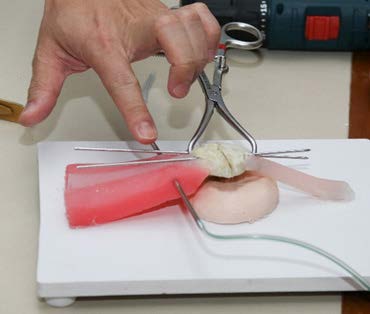Evaluation of Quality and Satisfaction of Patella Fracture Model for Teaching Tension Band Wiring Procedure
Main Article Content
Abstract
Objectives: To evaluate the quality and satisfaction of patella fracture model for teaching tension band wiring procedure.
Materials and Methods: The study was conducted at Siriraj hospital as a cross-sectional study by using questionnaire for evaluating the quality and satisfaction of patella fracture model. A total of 36 participants were participated in this study including orthopaedic surgeon orthopedic surgeons who have at least 5 years of teaching experience, the fourth-year orthopaedic residents and orthopaedic fellows in our institute and orthopaedic residents from other institutes. After performing the tension band wiring of patella fracture model, data were collected and analyzed by using number and percentage for categorical variables and mean and standard deviation for continuous variables.
Results: All 36 respondents consisted of 9 orthopaedic surgeons and 27 trainees which were residents and fellows. The results showed that overall rating for the quality of patella fracture model for orthopaedic surgeons was in the high level (Mean 3.67, S.D. 0.50) and for residents and fellows, it was in the high level (Mean 3.78, S.D. 0.58). Overall satisfaction of orthopaedic surgeons on patella fracture model appropriated for practicing tension band wiring procedure which was in the high level (Mean 4.33, S.D. 0.50) and for residents and fellows, the overall satisfaction was in the high level (Mean 4.38, S.D. 0.70).
Conclusion: Patella fracture model for practicing tension band wiring procedure for orthopaedic residency training program had overall high quality and satisfaction for learning experience. However, the flexibility of simulated tendon and muscle need to be improved.
Article Details

This work is licensed under a Creative Commons Attribution-NonCommercial-NoDerivatives 4.0 International License.
References
มณีรัตน์ ภัทรจินดา, ประสิทธิ์ เรืองเทพ และวัณณลภ โกวิท. การพัฒนาหุ่นฝีเย็บจำลองสำหรับ ฝึกเย็บแผลฝีเย็บ. โครงการวิจัยพัฒนานวัตกรรมหลักสูตรพยาบาลศาสตร์บัณฑิต คณะพยาบาลศาสตร์ มหาวิทยาลัยขอนแก่น, 2551.
ยุทธนา คณาสุข, ณัฐวุฒิ ศาสตรวาหา, สุรพล อธิประยูร, วรสัณห์ ทวีวุฒิทรัพย์ และปุณยธร พัฒนธิติกานต์. ความมั่นใจในการทำหัตถการออร์โธปิดิกส์หลังจบการศึกษา ของนิสิตแพทย์ มหาวิทยาลัยบูรพา. บูรพาเวชสาร, 2559;2:3-9.
วัณณลภ โกวิท. การผลิตหุ่นจำลองและสิ่งเลียนแบบทางการแพทย์. ฉบับปรับปรุงครั้งที่ 1 หมวดพิพิธภัณฑ์ หน่วยโสตทัศนศึกษา งานบริการศึกษา คณะแพทยศาสตร์ มหาวิทยาลัยขอนแก่น, 2547.
วาสนา ชาวหา. สื่อการเรียนการสอน. กรุงเทพมหานคร: สำนักพิมพ์ โอเดียนสโตร์, 2533.
ศศิกานต์ นิมมานรัชต์. ความมั่นใจและความถูกต้องของนักศึกษาแพทย์ในการใส่ท่อช่วยหายใจและการฉีดยาชาเข้าช่องน้ำไขสันหลัง. สงขลานครินทร์เวชสาร 2556;3:137-143.
สุวีณา เบาะเปลี่ยน, อริสรา อยู่รุ่ง, แอน ไทยอุดม, เนตรดาว ชัชวาลย์ และชยุตรา สุทธิลักษณ์. การพัฒนาหุ่นฝึกทักษะการดูดเสมหะทางท่อช่วยหายใจและท่อหลอดลมคอ: นวัตกรรมการศึกษาทางการพยาบาล. วารสารพยาบาลทหารบก 2561;3:62-70.






